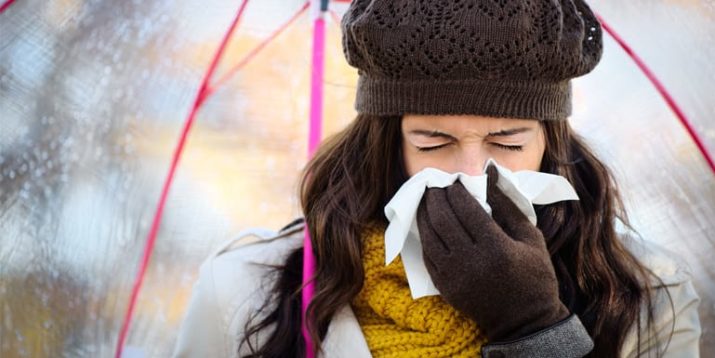Are You Sure That’s a Cold? A Guide to Winter Allergies

My mom always has the same advice, every time I complain about fall allergies that make me miserable: “Just wait until the first big freeze, then you’ll be fine.”
Insert (loving) eye roll here.
Sure, pollen loves to float in the air and make us miserable in the spring, and ragweed rears it’s ugly head in the fall, but are there other allergens that stick around in the winter once temperatures dip?
William Calhoun, M.D., a seasonal allergy expert from the University of Texas Medical Branch, says winter allergies can be worse than their warmer season counterparts. “What is different is that for the seasonal allergies, peak spring allergy season only lasts a few weeks,” says Calhoun. “In contrast, once the house is closed up for the winter, your ‘winter’ allergen exposure may last for months.”
And it’s a big problem: The American Academy of Allergy, Asthma, and Immunology estimates that winter allergies affect 50 million people in the United States, many of them from indoor irritants.
Is Your Home to Blame for Winter Allergies?
You can keep the cleanest house in the world and still suffer from sneezing, wheezing, and sinus pressure thanks to the various allergens that fill the indoor air during colder months.
“Indoor allergens, such as pet dander, dust mites and cockroaches, can accumulate in well-insulated homes and other indoor spaces,” Calhoun says. “In cold climates, people spend a greater fraction of their day indoors rather than outdoors, so their exposure to these winter allergens may be greatly increased.”
Mold also plays a big part in the winter allergy problem. Our home heating systems tend to make the air drier overall. Condensation that results from hot showers — along with lack of ventilation — creates the perfect environment for mold and mildew to grow and wreak havoc on your immune system.
How to Treat Winter Allergies
Luckily, the way you treat winter allergies is similar to the way you treat allergies in other seasons. Over-the-counter antihistamines and inhaled nasal corticosteroids — like those formulated with loratadine like Claritin and Zyrtec — may help to alleviate the signs. Your doctor can also prescribe stronger medications for the most stubborn symptoms.
In addition to medications, there are other potential solutions to consider. A 2005 study found that diets rich in omega-3 fatty acids (like salmon, eggs, and nuts) may lead to a decreased risk of allergic rhinitis, the medical term for the stuffiness and pressure that come from allergies. Also, a 2002 study from Swiss researchers found that the herb butterbur worked like cetirizine (the active ingredient in Zyrtec) to alleviate allergy symptoms.
Kick Winter Allergies to the Curb
The best way to treat allergies is to avoid them — but is that even possible? There’s no way to absolutely eliminate all the allergy triggers, but you can try to minimize exposure as much as possible.
“For dust mites, as an example, impermeable mattress and pillow coverings at bed-time are often recommended to reduce dust mite allergen exposure,” advises Calhoun, adding that washing bedding and blankets in hot water regularly also kills dust mites.
“Keeping pets out of the bedroom is very helpful for allergy sufferers,” adds Calhoun, since bathing them weekly can slough off the excess hair and dander. Replacing indoor carpeting with tile or hardwood floors may also reduce exposure. Calhoun suggests keeping high efficiency air filters in your furnace or air conditioning system. “They may offer benefits in some cases, but not always.”
Winter Allergies vs. Seasonal Colds
Winter is prime cold season, and the symptoms of winter allergies and colds are pretty similar. How can you tell the difference? By the timing and the symptoms. Colds usually go away after about a week, but allergy symptoms start as soon as you’re exposed to the allergen and stick around until the allergen is gone. As for symptoms, itchy eyes and clear, runny nose secretions typically point to allergies, whereas the symptoms of a cold may include fever, chills and thick mucus in the nose that is often colored (not clear). But, these symptoms vary from person to person and it’s best to see your doctor to receive optimal care.
